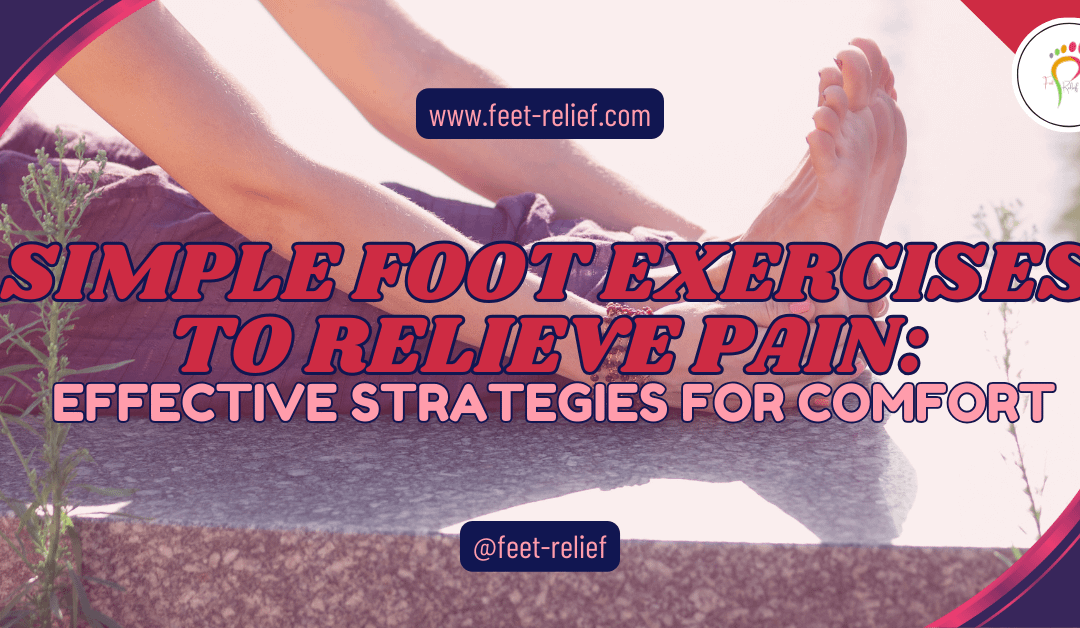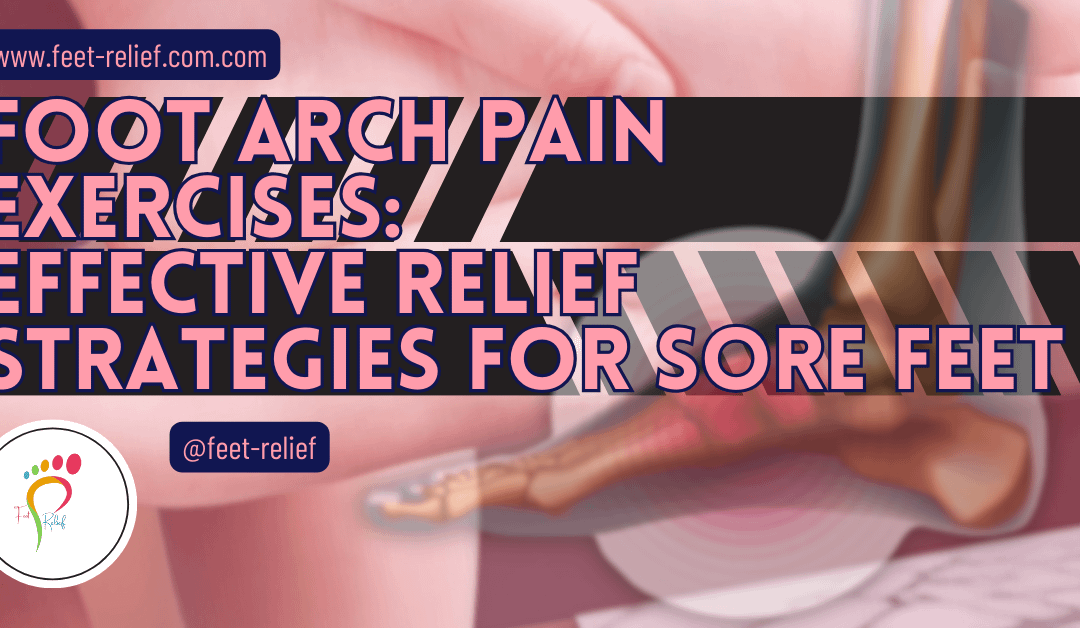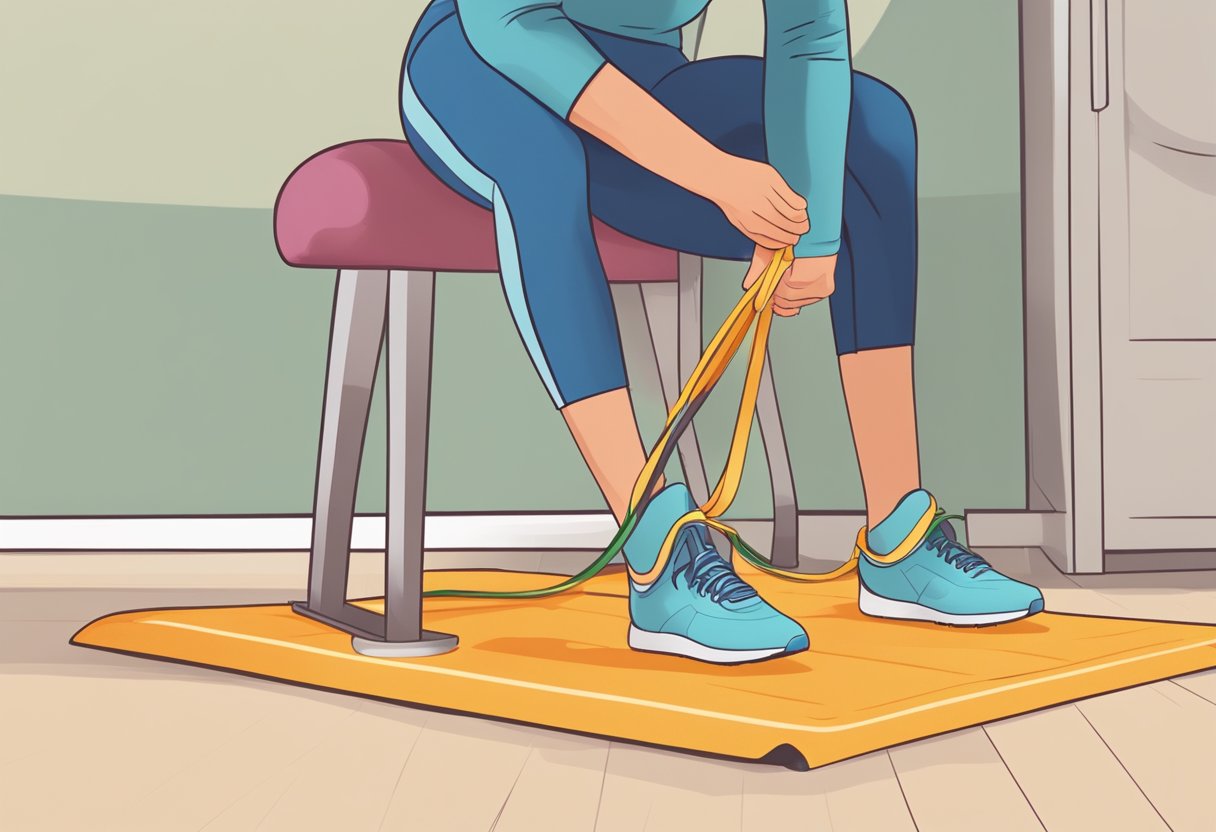
Simple Foot Exercises to Relieve Pain: Effective Strategies for Comfort
Simple foot exercises can relieve pain, strengthen your feet, and prevent future discomfort! They’re a great way to take care of the foundation that carries you everywhere you go. This guide will show you easy exercises, stretches, and self-care routines to keep your feet feeling happy and healthy.
Simple Foot Exercises to Relieve Pain: Improve Flexibility and Prevent Injury
Foot pain and discomfort can be a significant hindrance to daily activities, often caused by a variety of common foot problems. From the inherent complexity of foot anatomy to habitual routines that may place excessive strain on our feet, the reasons for pain can be numerous. Simple foot exercises, designed to address these issues, can play a crucial role in providing relief and improving overall foot health. By incorporating targeted stretches and strengthening exercises into your routine, you can address the source of foot pain, enhancing flexibility and resilience against potential injuries.
Understanding the structure of your feet and the types of activities that contribute to discomfort is the starting point for making positive changes. Regular foot exercises offer a proactive approach to preventing pain before it starts and can also serve as a therapeutic tool for existing conditions. Foot exercises, massage techniques, and proper cool down contribute to better foot care and can even be seamlessly integrated into your daily routine. The goal is to maintain the health of your feet in a way that supports your lifestyle and keeps you moving comfortably and confidently.

Key Takeaways
- Regular foot exercises can aid in relieving pain and preventing future discomfort.
- Knowledge of foot anatomy and awareness of daily activities can guide effective exercise choices.
- Integrating exercises and proper foot care into your routine supports ongoing foot health.

The Anatomy of the Foot
The foot is a complex structure made up of 26 bones, connected by a network of muscles, ligaments, and nerves. Understanding its anatomy is crucial for identifying the sources of foot pain and discomfort.
Bones and Their Functions
Your foot is an architectural marvel consisting of a total of 26 bones. These bones form two main parts:
- The Tarsal bones encompassing the ankle and heel and include seven bones: the talus, calcaneus, navicular, the medial, intermediate and lateral cuneiforms, and the cuboid.
- The Metatarsal and Phalangeal bones make up your midfoot and forefoot; the five metatarsal bones extend from your arch to your toes, while the phalanges make up your toe bones.
Each bone allows for the stability and mobility necessary for activities like walking, running, and balancing.
Muscles and Ligaments
Ligaments are strong, fibrous tissues that connect bones. The most important ligaments in your foot include:
- The plantar fascia, which supports the arch of your foot and provides shock absorption.
- The Achilles tendon, connecting your calf muscles to the heel, crucial for walking and running.
Muscles in the foot, such as the intrinsic muscles, maintain arch support and control fine movements. Extrinsic muscles originate in the lower leg and control larger movements.
Nerve Supply and Pain Points
The foot’s nerve supply is responsible for sensation and movement. The plantar nerves are vital, affecting your foot’s bottom and transmitting signals about pressure and pain. Particular nerve points linked to pain include:
- The medial plantar nerve, often involved in plantar fasciitis.
- The tarsal tunnel, where nerve compression can lead to pain and tingling.
Understanding these key nerve areas is essential for identifying nerve-related foot discomfort.
Common Foot Problems Leading to Pain
Experiencing foot pain can be limiting and frustrating. Various foot problems may lead to discomfort, and understanding them is key to finding relief.

Plantar Fasciitis
Bunions
These bony bumps develop at the base of your big toe, causing it to veer toward the others. Bunions can lead to persistent or intermittent pain, and improper footwear may exacerbate the issue.
Hammertoe
A deformity where the toe bends at the middle joint, leading to discomfort when walking. It often results from tight-fitting shoes and can be accompanied by corns or calluses.
Arthritis
This joint inflammation can affect your feet, resulting in pain, stiffness, and reduced mobility. The most common form affecting the foot is osteoarthritis, but rheumatoid arthritis can also cause foot problems.
To alleviate foot pain, consider engaging in:
- Stretching exercises
- Strength-building activities
- Flexibility routines
For example, picking up marbles with your toes can enhance toe strength and dexterity. Conversely, if you have arthritis, gently bending the toes toward your ankle might provide some relief as per the guidance on CreakyJoints.
If foot pain persists, consult a healthcare professional for a personalized assessment and treatment plan.
Preparation for Foot Exercises
Before diving into foot exercises that can alleviate discomfort, preparing your feet properly is essential to maximize benefits and minimize injury.
Warm-Up Techniques
To prevent strain, warm up your feet with gentle movements. Slowly walk around the room to increase blood flow. Additionally, you can perform toe curls and gentle stretches, such as stretching the big toe to enhance mobility before engaging in more intensive exercises.
Safety Tips Before Exercise
Prior to starting your foot exercises, ensure you’re in a safe environment. Clear the area of any obstacles and wear comfortable, non-restrictive clothing. If you’re on a slippery surface, use a mat or wear non-slip socks to maintain stability. Always listen to your body—if you feel pain beyond mild discomfort, stop the exercise and consult a professional. For more detailed exercise instructions, reference sources like Healthline’s foot exercises for expert guidance.
Stretches to Alleviate Foot Pain
Proper stretching can effectively manage your foot pain by enhancing flexibility and reducing tension. Here’s how to perform targeted stretches addressing different areas of your foot.
Toe Stretches
To maintain mobility in your toes and prevent or ease pain, start with these simple toe stretches. Extend your leg and point your toes forward, then pull them back towards your shin. Perform this movement several times to help improve circulation and flexibility.
Arch Stretches
Arch pain can often be alleviated through consistent stretching. Sit with your feet flat on the ground, then raise your heel to stretch the arch of your foot. You can also use a rolled-up towel or a tennis ball beneath your foot while seated, slowly rolling it beneath your arch to gently stretch the area.
Heel Stretches
For heel stretches, a common cause of discomfort is plantar fasciitis, which can benefit from specific stretches. Stand facing a wall with one foot behind you. Keep your heel on the ground and gently lean into the wall until you feel a stretch in the back of your lower leg. Hold this position to help loosen the Achilles tendon and relieve heel pain.
Strengthening Exercises for Foot Health
Strengthening exercises play a crucial role in maintaining foot health, helping alleviate pain, and increasing stability. These targeted movements can enhance muscular support and joint function in your feet.
Toe Grip and Release
This exercise works on the tiny muscles between your toes which improve grip and balance. Place a small towel on the floor and use your toes to scrunch it towards you, then release. Aim for 10 repetitions with each foot.
Arch Lifts
Arch lifts focus on strengthening the intrinsic muscles, which support the arch of your foot. Stand with your feet flat on the ground, then raise only the arches of your feet while keeping your toes and balls of your feet on the floor. Hold for a count of 5 seconds before lowering. Repeat 15 times.
Ankle Flexes
Ankle flexes can enhance the flexibility and strength of the muscles in your shins and the back of your calf. Sit with your legs extended, and flex your ankles by pointing your toes away from you and then pulling them back toward your shins. Perform this exercise in 3 sets of 10 repetitions for each foot.
Massage Techniques for Foot Relief
Applying specific massage techniques can significantly reduce foot pain and discomfort. These targeted methods stimulate circulation, ease tension, and help in muscle relaxation.
Self-Massage Methods
Toes Pull and Squeeze: Begin by interlacing your fingers with your toes to create gentle tension. Squeeze softly and then pull each toe smoothly, enhancing mobility and circulation.
Arch Kneading: With your thumb, apply moderate pressure to the arch of your foot and move in a kneading motion. This helps alleviate the stiffness in the plantar fascia.
Using Massage Tools
Roller Device: Place a foot roller on the ground and gently roll your foot over it. This method can mimic the pressure and movement similar to a massage therapist’s hands.
Electric Massager: For a deeper massage, an electric foot massager with various settings can provide relief from foot cramps and tension by offering consistent and controllable pressure.
Cool Down and Foot Care After Exercise
Properly cooling down your feet after intense activity is as crucial as the exercise itself, helping to alleviate pain and prevent injury. Good foot hygiene and moisturizing are also essential for maintaining overall foot health.
Stretching as Cool Down
After exercising, it is important to perform foot stretches to enhance flexibility and reduce muscle tension. A simple towel stretch can effectively target the muscles of your feet. Sit with your legs extended, wrap a towel around the ball of your foot, and gently pull toward you until you feel a stretch but no pain. Hold this for 15-30 seconds and repeat with the other foot.
Another beneficial stretch is the Legs-Up-the-Wall Pose, which can aid in circulation and recovery. Position yourself so that your hips are close to a wall and your legs are resting upward against the wall. Remain in this pose for 5-10 minutes to experience the full benefits.
Foot Hygiene and Moisturizing
After stretching, clean your feet with soap and warm water, ensuring you clean between the toes to prevent fungal infections. Once dry, apply a quality, fragrance-free moisturizer to keep the skin on your feet supple. This is particularly crucial if you’re prone to dryness or cracks in your heels. Pay extra attention to areas that may experience more friction from your footwear to prevent calluses and blisters.
Incorporating Foot Exercises into Daily Routine
Incorporating foot exercises into your daily routine is a straightforward process that can lead to significant relief from foot pain and discomfort. Below are simple steps to seamlessly integrate these exercises into your day.

Morning Activation:
Start your day by waking up your feet. A simple foot rolling exercise using a foam roller or tennis ball can stimulate blood flow and alleviate any stiffness from sleeping.
- Place a tennis ball under your foot.
- Gently roll it back and forth from your heel to your toes.
- Repeat for a few minutes on each foot.
Midday Stretching:
Taking a short break during the day for some toe stretches can prevent cramps and fatigue.
- Sit with legs extended, reaching for your toes.
- Pull gently towards you, holding for a few seconds.
- Release and repeat multiple times.
Evening Strength:
In the evening, focus on exercises that strengthen the muscles in your feet. This can help prevent injury and chronic conditions.
- Stand with feet shoulder-width apart.
- Slowly raise onto your tiptoes and hold for a count of five.
- Lower back down and repeat 10-15 times.
By dedicating just a few minutes at various points in the day to these exercises, you can build a routine that supports foot health without overwhelming your schedule. Choose exercises that are easy for you to do anywhere, whether at home or in the office. Consistency is key; aim to perform these exercises daily for the best results.
When to Consult a Professional
While many foot problems can be addressed with simple exercises, certain symptoms may indicate the need to seek professional medical advice. If you experience any of the following, contact a podiatrist:

- Persistent Pain: If you have pain that doesn’t improve after a few days of self-care or if the pain escalates, it can be a sign of a more serious condition.
- Injury: If you suspect a fracture, sprain, or strain, a professional can provide an accurate diagnosis and treatment plan.
- Numbness or Tingling: These sensations, particularly if occurring frequently, could suggest nerve damage or other complex issues.
- Visible Changes: Changes in the color or structure of your feet or toes, such as persistent sores, severe cracking, or deformities, may require a professional’s intervention.
For a deeper understanding of common foot issues, consider reading about when to see a podiatrist. Remember, timely intervention by a healthcare professional can prevent complications and help in effective management of foot-related problems. If in doubt, it’s always prudent to err on the side of caution and make an appointment with a specialist. It’s important to listen to your body and respond appropriately to the signals it sends.
Simple Foot Exercises to Relieve Pain: Take Control of Your Foot Health
Foot pain can be a real drag, but the good news is you don’t have to suffer in silence. Simple foot exercises can be a powerful tool in your pain-relief arsenal. This guide explored the wonders of foot anatomy, common culprits behind foot woes, and most importantly, effective exercises and self-care routines to get you back on your feet comfortably.
We learned that incorporating targeted stretches and strengthening exercises into your day can significantly improve flexibility, strengthen muscles, and even prevent future injuries. From toe stretches and arch massages to cool-down routines and proper foot hygiene, this guide offered a roadmap to happy and healthy feet.
Thank you for taking an interest in your foot health! Remember, consistency is key. By dedicating just a few minutes each day to these simple exercises, you can make a world of difference in your overall well-being. So, why wait? Lace up your sneakers or grab a comfy chair, and get ready to experience the joy of pain-free movement!
Frequently Asked Questions
In this section, we address common inquiries about exercises that can alleviate foot pain and improve foot health.
What are the most effective stretching exercises to alleviate foot pain?
Stretching exercises for foot pain often target the plantar fascia and Achilles tendon. Plantar fascia stretches and Achilles tendon stretches can help relieve tension and discomfort in your feet.
Which exercises can help strengthen the muscles in my feet and ankles?
To strengthen your feet and ankles, try exercises that focus on improving balance and muscle control. Heel raises and toe grips using marbles are particularly effective for these areas.
How can I modify foot exercises to be safe and beneficial for seniors?
Seniors can modify foot exercises by performing them seated and using support when necessary. Gentle stretches and mobility exercises can maintain flexibility without risking balance.
What are some quick techniques for immediate foot pain relief?
A quick technique for immediate relief is to roll your foot over a ball, providing a massaging effect. This method is helpful for conditions like plantar fasciitis or arch pain.
Can you recommend any videos that demonstrate foot exercises for pain management?
Online platforms such as YouTube have a variety of videos that demonstrate foot exercises. Look for reputable practitioners or physical therapists who offer demonstrations on exercises and stretches for foot health.
What non-exercise methods can complement physical therapy for foot discomfort?
Alongside exercises, you can explore massage, proper footwear, and rest to complement physical therapy. These measures can enhance pain relief and support recovery from foot discomfort.
Conquer Foot Pain and Thrive!
Discover a treasure trove of helpful content and connect with a supportive community on feet-relief.com! Explore insightful product reviews, engage with fellow foot health enthusiasts, and unlock the secrets to happy, healthy feet. Join us on Facebook too: https://www.facebook.com/4feet.relief!



















